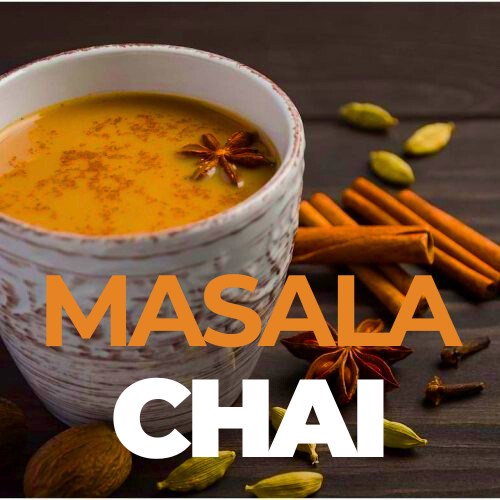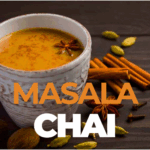What Are the Ingredients of Masala Chai? The Ultimate Guide
What are the ingredients of masala chai? Masala chai—the term itself evokes the warm, spicy aroma of Indian kitchens and bustling street stalls. This flavorful beverage has won hearts worldwide for its unique combination of tea, milk, spices, and sweetness. But exactly what are the ingredients of masala chai? Is there one definitive recipe, or does it vary?
In this comprehensive guide, we explore the traditional and modern ingredients of masala chai, how each contributes to its iconic taste, and how you can customize it to your liking. We’ll also cover the health benefits of each component and provide answers to the most frequently asked questions about masala chai ingredients.
What Is Masala Chai?
Masala chai translates literally to “spiced tea” in Hindi (masala = spice blend, chai = tea). Originating from the Indian subcontinent, masala chai combines black tea with a variety of spices, milk, and sweeteners, resulting in a rich, warming beverage.
Unlike regular black tea, masala chai is brewed with spices that create a distinct aroma and flavor profile. Its preparation varies across regions and families, reflecting personal preferences and cultural traditions.
The Core Ingredients of Masala Chai
While there is no one-size-fits-all recipe, certain ingredients are fundamental to authentic masala chai. Let’s break them down.
1. Black Tea Leaves
Role: The backbone of masala chai.
Common Varieties Used:
- Assam tea: Known for its robust, malty flavor.
- Darjeeling tea: Lighter with floral notes.
- Nilgiri tea: Fragrant with a smooth taste.
Why it matters: Black tea provides the base for the spices and milk to meld, creating the characteristic full-bodied flavor of masala chai. Loose-leaf tea is often preferred for its superior quality, but tea bags can be used for convenience.
2. Spices (Masala)
The “masala” in masala chai refers to the blend of spices that infuse the tea with warmth and complexity. The exact combination can vary widely, but these are the most commonly used spices:
a) Cardamom (Elaichi)
- Flavor profile: Sweet, floral, and slightly citrusy.
- Function: Adds an aromatic sweetness and balances bolder spices.
b) Ginger (Adrak)
- Flavor profile: Pungent and spicy.
- Function: Offers warmth and a slight kick; also aids digestion.
c) Cloves (Laung)
- Flavor profile: Intense, warm, and slightly bitter.
- Function: Adds depth and complexity.
d) Cinnamon (Dalchini)
- Flavor profile: Sweet and woody.
- Function: Enhances the overall sweetness and warmth of the chai.
e) Black Peppercorns (Kali Mirch)
- Flavor profile: Sharp and pungent.
- Function: Adds a subtle heat and stimulates digestion.
f) Fennel Seeds (Saunf) [Optional]
- Flavor profile: Sweet, anise-like.
- Function: Softens the pungency of other spices.
g) Star Anise [Optional]
- Flavor profile: Licorice-like.
- Function: Adds an exotic sweet-spicy flavor.
Note: Not all masala chai recipes include all these spices. The blend depends on regional preferences and personal taste.
3. Milk
Types Commonly Used:
- Whole milk (most traditional)
- Skimmed or low-fat milk
- Plant-based alternatives (soy, almond, oat, coconut)
Why it matters: Milk adds creaminess and mellows the intensity of the spices and tea, creating the signature smooth texture of masala chai.
Pro Tip: For a richer chai, use full-fat milk. For a vegan masala chai, opt for plant-based milks that complement spices well.
4. Sweetener
Traditional Choices:
- White sugar
- Jaggery (unrefined cane sugar)
- Honey
Modern Variations:
- Brown sugar
- Maple syrup
- Stevia or other sugar substitutes
Why it matters: Sweeteners balance the bitterness of black tea and the pungency of spices. The amount and type of sweetener significantly affect the final flavor.
5. Water
Function: Serves as the initial medium to extract the flavors from the tea leaves and spices.
Ratio: Typically, water and milk are combined in a 1:1 ratio, but this can be adjusted based on preference for creaminess.
Optional Ingredients
Many households add unique ingredients to personalize their masala chai:
- Nutmeg: For extra warmth.
- Saffron: Adds luxury and subtle floral notes.
- Bay leaves: Introduces earthy tones.
- Mint leaves: For a refreshing twist.
- Lemongrass: Common in some South Indian versions.
The Importance of Each Ingredient
Each ingredient in masala chai plays a specific role:
| Ingredient | Function |
|---|---|
| Black tea | Provides body, tannins, and caffeine. |
| Spices | Infuse aroma, warmth, and complexity. |
| Milk | Softens flavors and adds creaminess. |
| Sweetener | Balances bitterness and enhances flavor. |
| Water | Medium for brewing, moderates strength. |
How to Make Traditional Masala Chai
Ingredients:
- 2 cups water
- 2 cups milk
- 2 tablespoons black tea leaves
- 2-3 crushed cardamom pods
- 1 small piece of cinnamon stick
- 2-3 cloves
- 3-4 black peppercorns
- 1-inch piece of fresh ginger, grated
- 2 teaspoons sugar (or to taste)
Instructions:
- In a saucepan, bring water to a boil.
- Add spices and simmer for 3-5 minutes to extract flavors.
- Add black tea leaves and simmer for 1-2 minutes.
- Pour in milk and bring the mixture to a gentle boil.
- Add sugar and stir well.
- Strain and serve hot.
Regional Variations of Masala Chai Ingredients
Mumbai Cutting Chai
- Stronger tea with less milk.
- Often more ginger and cardamom.
Kashmiri Chai (Noon Chai)
- Uses green tea.
- Includes salt, baking soda, and is pink in color.
- Garnished with nuts and sometimes saffron.
South Indian Masala Chai
- Often features lemongrass.
- Spices may be fewer for a lighter taste.
Health Benefits of Masala Chai Ingredients
1. Black Tea
- Rich in antioxidants like theaflavins.
- Boosts heart health.
2. Ginger
- Aids digestion.
- Anti-inflammatory.
3. Cardamom
- Promotes oral health.
- Aids in detoxification.
4. Cloves
- Contains eugenol, which has antimicrobial properties.
5. Cinnamon
- Regulates blood sugar.
- Antioxidant-rich.
6. Black Pepper
- Enhances nutrient absorption.
- Anti-inflammatory.
Common Mistakes to Avoid When Using Masala Chai Ingredients
- Overboiling the milk: Can cause curdling.
- Using too many spices: Overpowering the tea.
- Not crushing spices: Whole spices release less flavor.
- Adding tea too early: Can result in bitterness.
- Skipping fresh ginger: Ground ginger is less aromatic.
Tips for Customizing Masala Chai Ingredients
- Prefer more spice? Increase ginger and black pepper.
- Want it sweeter? Add more sugar or try jaggery.
- Vegan? Use plant-based milk.
- Low-caffeine? Use decaffeinated black tea.
Why Understanding the Ingredients of Masala Chai Matters
Knowing what the ingredients of masala chai are allows you to:
- Customize your brew.
- Appreciate regional variations.
- Maximize health benefits.
- Avoid common mistakes.
- Share the authentic chai experience with others.
SEO-Optimized FAQs About Masala Chai Ingredients
1. What spices are typically used in masala chai?
The most common spices in masala chai include cardamom, ginger, cloves, cinnamon, and black pepper. Some recipes also include fennel seeds, nutmeg, star anise, or bay leaves depending on regional preferences.
2. Can I make masala chai without milk?
Yes, you can make masala chai without milk, often called “black masala chai.” However, traditional masala chai usually includes milk to balance the strength of the tea and spices, creating a creamy texture.
3. Is it necessary to use all the spices in masala chai?
No, it’s not necessary to use all the spices. Masala chai is highly customizable. The essential idea is to balance warming spices with black tea and sweetness. Some prefer simple versions with just ginger and cardamom, while others enjoy more complex blends.
4. What is the best tea for masala chai?
The best tea for masala chai is typically a robust black tea like Assam or CTC (Crush, Tear, Curl) tea. These teas hold up well to the strong flavors of the spices and milk.
5. Can I use ground spices instead of whole spices for masala chai?
Yes, you can use ground spices for convenience. However, whole spices are generally preferred as they impart a fresher, more nuanced flavor when simmered in water and milk.
6. What’s the difference between chai and masala chai?
“Chai” simply means “tea” in Hindi. Masala chai specifically refers to spiced tea—a mixture of black tea, milk, sweetener, and spices. Outside of India, “chai” often colloquially refers to masala chai.
7. Is masala chai healthy?
Yes, masala chai can be healthy when consumed in moderation. Its ingredients like ginger, cardamom, cinnamon, and cloves offer various health benefits, including improved digestion, antioxidant properties, and anti-inflammatory effects. However, watch the sugar content for optimal health benefits.
8. Can I make vegan masala chai?
Absolutely! Use plant-based milks such as oat, almond, soy, or coconut. Ensure the chosen milk complements the spices well, and adjust sweetness accordingly.
9. How much spice should I use in masala chai?
The amount of spice is subjective. A general guideline is:
- 2-3 cardamom pods
- 1-inch ginger
- 1 cinnamon stick
- 2-3 cloves
- 3-4 peppercorns
You can adjust these based on your spice tolerance.
10. Can I prepare masala chai spice mix in advance?
Yes! Many people create a masala chai powder or spice blend in advance by grinding and mixing the spices. Store in an airtight container for up to six months for convenience and consistency in flavor.
Conclusion
Masala chai is more than just a drink—it’s a cultural experience and a comforting ritual. Understanding what are the ingredients of masala chai enables you to craft a brew that suits your palate, whether you prefer it robust and spicy or mild and sweet.
Experiment with different spice ratios, types of tea, and sweeteners to create your perfect cup. With every sip, you’re partaking in a tradition that has been cherished for centuries.
Ready to Make Your Own Masala Chai?
Try out the recipe above, or purchase a pre-made masala chai blend from your local spice shop. Don’t forget to share your favorite combinations in the comments!
Related Posts:
- How to Brew the Perfect Masala Chai
- Top 10 Health Benefits of Masala Chai
- The History and Cultural Significance of Chai in India
Meta Description: Discover what are the ingredients of masala chai, including traditional spices, tea types, and optional additions. Learn how to customize your masala chai with our complete guide.





